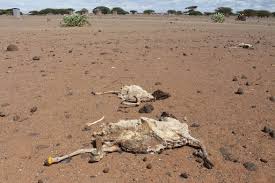
Carcass of a livestock/File
As extreme heat hit many countries, the UN Environment Programme has warned of heightened health risks for older persons.
Other areas like Nairobi, Mombasa and Kisumu have also recorded heatwave events.
Increased heat stress to outdoor workers, including those preparing farms for the next cropping season, affect productivity and health.
It also increases the likelihood of wildfires, as high temperatures and dry conditions sustain conducive environmental conditions for wildfires.
Heat waves also worsen respiratory diseases such as asthma.
The elevated levels of heat stress are likely to cause dehydration, exhaustion, fainting, and, in extreme cases, heat stroke in humans.
It also leads to reduced livestock productivity, especially milk, and grazing time for animals due to excess thermal heat comfort.
In March, the Intergovernmental Authority on Development (IGAD) released the March-May forecast, which projected a higher likelihood of warmer-than-normal conditions across most parts of the IGAD region.
Weekly forecasts generated throughout February indicated the persistence of warmer-than-usual temperature anomalies across most parts of the Greater Horn of Africa (GHA), putting the region at a likelihood of extreme temperature hazards.
Further, analysis of the observed temperatures in February indicated most areas in South Sudan, Uganda, and northern and western Kenya experienced persistence of extreme temperatures.
The analysis of the average daily maximum temperatures from February 1 to 28 indicates that much of South Sudan, parts of southeastern Sudan, northern Kenya, and southern Somalia experienced temperatures exceeding 38°C.
IGAD said with daily maximum temperatures hitting 40 degrees Celsius in parts of South Sudan and Kenya, there was a high chance of extreme temperatures negatively affecting humans, livestock and socio-economic activities.
The 7th edition of the Frontiers Report, The Weight of Time—Facing a New Age of Challenges for People and Ecosystems, is part of Unep’s Foresight Trajectory initiative and highlights emerging environmental issues as well as potential solutions.
The first edition in 2016 warned of the growing risk of zoonotic diseases, three years before the Covid-19 pandemic.
This report is released as communities across China, Japan, India, Europe, the USA, and elsewhere face weeks of extreme heat and flooding.
Adults aged 65 and above now form an increasingly dominant part of the world population, particularly in urban areas of low- and middle-income countries.
The report notes that annual heat-related deaths among older persons have risen by an estimated 85 per cent since the 1990s.
Additional risks arise from deteriorating air quality and floods in low-lying coastal cities where older persons live.
Older persons—especially those with chronic illnesses, limited mobility, or frailty—are particularly vulnerable to heat-related health issues, including respiratory, cardiovascular, and metabolic diseases, as well as increased mortality.
The report recommends making cities pollution-free, resilient and accessible spaces with expansive vegetation.
Key strategies include better urban planning, community-based disaster risk management, and improved access to climate information for older populations.
Earlier this year, the UN Human Rights Council adopted a new resolution to develop an “international legally binding instrument on the human rights of older persons,” a possible path to add safety to those most exposed to climate change.











